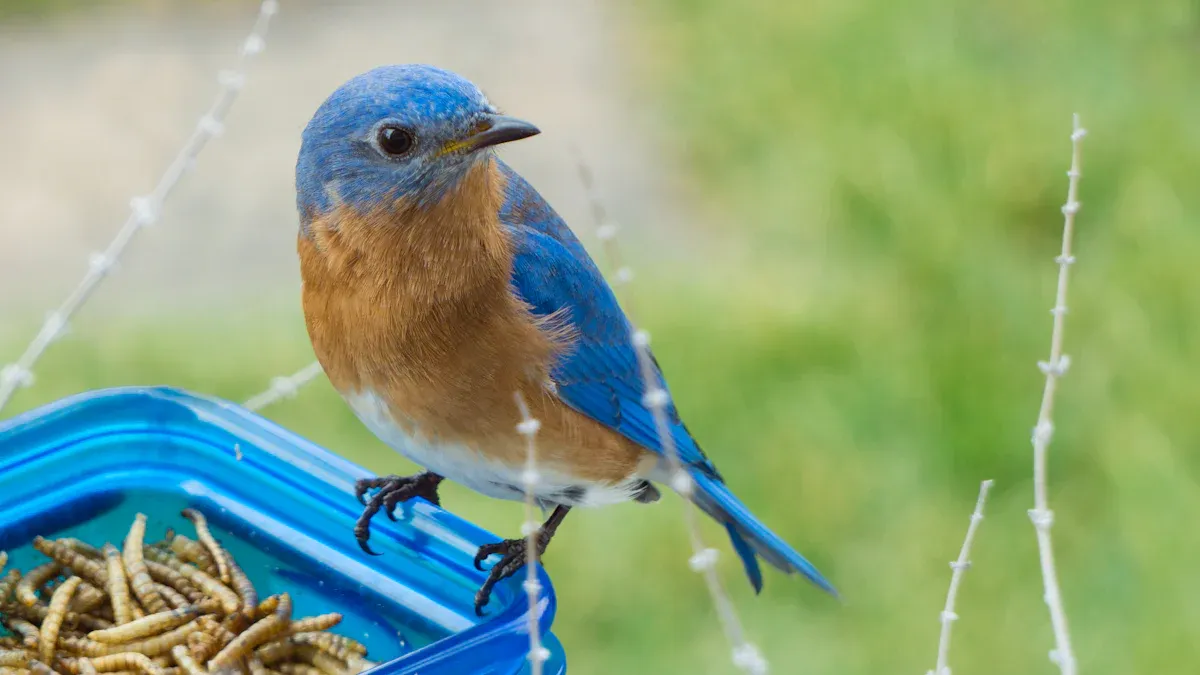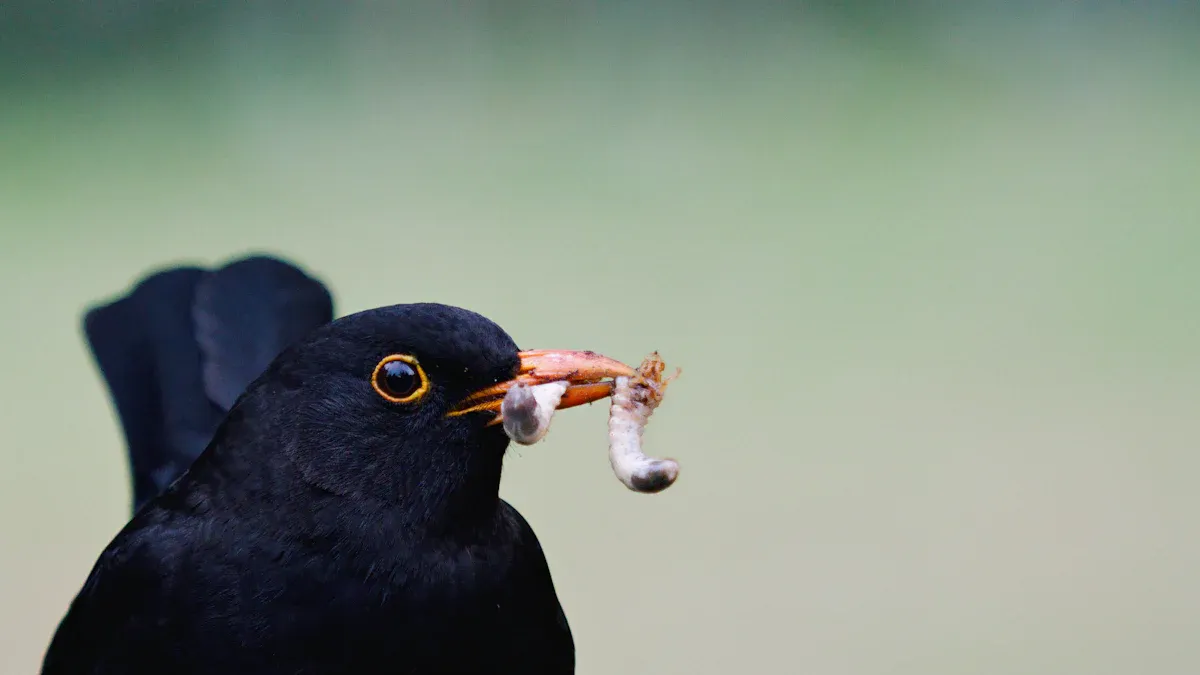
Bird feed mealworms pack a powerful punch of protein and nutrients that birds need to stay healthy. These tiny treats are especially helpful during colder months when natural food sources become scarce.
Mealworms are a rich source of energy and digestible amino acids, making them an excellent choice for avian diets.
Their high protein content—ranging from 25% to 60%—supports bird growth, energy, and reproduction. Plus, they mimic the insects birds naturally crave, attracting a variety of species to your yard.
Key Takeaways
- Mealworms have lots of protein and important nutrients. They help birds grow, stay active, and reproduce.
- Feeding mealworms brings many bird types to your yard. This makes your yard lively and full of color.
- Use live mealworms first to get birds interested. Later, switch to dried ones for easier and all-year feeding.
Why Bird Feed Mealworms Are Essential for Bird Health

Nutritional Benefits of Mealworms
Mealworms are a powerhouse of nutrition, offering birds the essential nutrients they need to thrive. Packed with high levels of protein and fat, they provide a concentrated energy source that supports birds during their most active periods. Here’s a quick look at the key nutrients found in mealworms and their benefits:
| Nutrient | Benefits |
|---|---|
| Protein | Builds and repairs muscles, keeping birds strong and active. |
| Fat | Supplies energy and promotes healthy feathers and skin. |
| Fiber | Aids digestion and supports gut health. |
| Vitamins | Includes B vitamins like B12 and B2, crucial for energy metabolism. |
| Minerals | Contains iron, calcium, magnesium, and zinc for bone strength and immunity. |
Mealworms also contain essential amino acids that are vital for feather growth and overall development. Birds rely on these nutrients to maintain their vibrant plumage, especially during molting seasons. Plus, their soft texture makes them an ideal food for young chicks and smaller bird species.
Tip: Offering Bird Feed Mealworms in your yard not only nourishes birds but also attracts a variety of species, creating a lively and colorful environment.
How Mealworms Enhance Bird Energy, Growth, and Reproduction
Birds expend a lot of energy during activities like flying, nesting, and migration. Mealworms provide the perfect fuel to meet these demands. With a crude protein content ranging from 43.3% to 60.2% and an energy value of 598 kcal per 100 grams, mealworms are a high-energy snack that keeps birds active and healthy.
- Energy Boost: The high protein and fat content in mealworms helps birds sustain their energy levels during long flights or busy nesting periods. Migratory birds, in particular, benefit from this nutrient-dense food as it prepares them for their arduous journeys.
- Growth Support: Studies show that including mealworms in bird diets significantly improves weight gain and feed conversion efficiency. For example, research on Japanese quails revealed that adding 22.5g to 30g of mealworms per kilogram of feed enhanced their body weight and overall health.
- Reproductive Health: Mealworms play a crucial role in supporting reproduction. The rich protein content aids in egg production, while the vitamins and minerals strengthen the immune system of both parent birds and their chicks.
| Study | Bird Species | Mealworm Inclusion | Key Findings |
|---|---|---|---|
| Hong et al. 2020 | Broiler chicks | 5%, 10%, 15% | Increased body weight and daily feed intake. |
| Loponte et al. 2017 | Barbary partridge | 25%, 50% | Improved live weight and feed conversion rates. |
| Zadeh et al. 2019 | Japanese quails | 22.5g, 30g/kg | Enhanced body weight and feed efficiency. |
Live mealworms offer an added advantage—they provide hydration, which is especially important during dry seasons or when water sources are limited. This dual benefit of nutrition and hydration makes Bird Feed Mealworms an indispensable part of a bird’s diet.
Watching birds thrive on mealworms is a rewarding experience. Their energy, vibrant feathers, and lively behavior are a testament to the power of this protein-rich treat.
Practical Ways to Incorporate Bird Feed Mealworms

Choosing Between Live and Dried Mealworms
Bird enthusiasts often wonder whether live or dried mealworms are better for their feathered visitors. Both options have unique benefits, and the choice depends on the birds’ needs and the feeder’s convenience.
Live mealworms are closer to what birds find in nature. Their movement grabs attention, making them irresistible to birds. They also provide hydration, which is especially helpful during dry seasons. On the other hand, dried mealworms are easier to store and handle. They last longer and can be offered year-round without worrying about spoilage.
Here’s a comparison of nutritional values between live and dried mealworms:
| Parameter | Before Drying | Rack Oven Dried | Vacuum Dried | Freeze Dried |
|---|---|---|---|---|
| Moisture (g/100g) | 62.87 ± 0.27 | 0.87 ± 0.03 | 1.70 ± 0.09 | 9.83 ± 0.03 |
| Protein (g/100 g DM) | 53.53 ± 0.28 | 56.30 ± 0.32 | 53.23 ± 0.20 | 52.23 ± 0.19 |
| Fat (g/100 g DM) | 27.13 ± 0.03 | 27.27 ± 0.09 | 29.57 ± 0.02 | 26.80 ± 0.06 |
| Fiber (g/100 g DM) | 6.47 ± 0.09 | 7.10 ± 0.06 | 6.83 ± 0.03 | 7.53 ± 0.09 |
| Ash (g/100 g DM) | 3.27 ± 0.12 | 3.43 ± 0.18 | 3.40 ± 0.15 | 3.43 ± 0.12 |
Live mealworms have higher moisture content, making them ideal for hydration. Dried mealworms, however, retain their protein and fat levels, offering a concentrated energy source.
Tip: Start with live mealworms to attract birds, then gradually introduce dried ones for convenience.
Tips for Introducing Mealworms to Birds
Introducing mealworms to birds can be a fun and rewarding experience. Birds may need time to recognize mealworms as food, but a few simple strategies can help.
- Start with live mealworms: Their movement naturally catches birds’ attention. Once birds get used to them, dried mealworms can be offered as an alternative.
- Use a platform feeder: Place mealworms on a flat surface to keep them contained. This prevents live mealworms from escaping and makes it easier for birds to access them.
- Limit feeding quantities: Mealworms should complement a bird’s diet, not replace it. Offering them as a treat ensures birds receive a balanced mix of nutrients.
Watching birds discover mealworms for the first time is a delightful experience. Their curiosity and excitement make the effort worthwhile.
Mixing Mealworms with Other Bird Foods
Mealworms can be combined with other bird foods to create a balanced and appealing mix. Mixing them with seeds, suet, or fruits can attract a wider variety of bird species.
- Seeds and grains: Adding mealworms to seeds enhances the protein content of the mix. Birds like sparrows and finches enjoy this combination.
- Suet cakes: Embedding dried mealworms into suet cakes provides a high-energy snack for woodpeckers and nuthatches.
- Fruits: Pairing mealworms with fruits like berries or apple slices offers a nutritious treat for thrushes and robins.
Tip: Experiment with different combinations to see which mix attracts the most birds to your yard.
Mealworms are versatile and easy to incorporate into bird diets. Whether offered alone or mixed with other foods, they provide essential nutrients that support bird health and vitality.
Safe and Effective Use of Bird Feed Mealworms
Storage and Handling Tips
Proper storage and handling of mealworms ensure their safety and quality. Live mealworms should be kept in the refrigerator to keep them dormant and extend their lifespan. A container with steep sides, like glass or plastic, works best to prevent escape. Adding slices of potato or apple provides moisture, but it’s important to check for mold regularly. Sifting out frass (waste) and refreshing the bedding keeps the environment clean and healthy. These steps help maintain the nutritional value of Bird Feed Mealworms while ensuring they remain safe for birds.
Precautions to Avoid Overfeeding
While mealworms are a nutritious treat, overfeeding can lead to imbalances in a bird’s diet. Birds may favor mealworms over other foods, which could result in nutrient deficiencies. Offering mealworms in moderation ensures they complement, rather than replace, a bird’s natural diet. A good rule of thumb is to provide mealworms as a treat, not a primary food source. This approach keeps birds healthy and prevents dependency on a single food item.
Ensuring Mealworms Are Part of a Balanced Diet
Mealworms are an excellent addition to a bird’s diet when paired with other foods. Studies show that birds, like great tits, prefer mealworms with higher carotenoid levels, which enhance their health and plumage. Combining mealworms with seeds, fruits, or suet creates a balanced mix that meets various nutritional needs. For example:
| Study | Findings |
|---|---|
| Bilby and Widdowson | Nutritional quality of insects benefits nestling birds’ development. |
| Specific Appetite for Carotenoids | Birds prefer mealworms with higher carotenoid content. |
By offering a variety of foods, bird enthusiasts can ensure their feathered visitors receive a well-rounded diet.
Bird Feed Mealworms offer birds the nutrition they need to thrive. Their protein-rich content boosts energy, supports growth, and enhances reproduction. Adding mealworms to bird diets creates a healthier, more vibrant environment. Watching birds enjoy this treat is a joy for any bird lover. Try them today and see the difference they make!
FAQ
What types of birds eat mealworms?
Many birds enjoy mealworms, including bluebirds, robins, wrens, and chickadees. Even woodpeckers and cardinals find them irresistible!
How often should I feed mealworms to birds?
Offer mealworms as a treat 2–3 times a week. This keeps their diet balanced while providing a protein boost.
Can I feed mealworms to baby birds?
Yes! Mealworms are soft and easy to digest, making them perfect for baby birds. They support healthy growth and feather development.
Tip: Always provide fresh mealworms and clean feeders regularly to keep birds safe and healthy.


